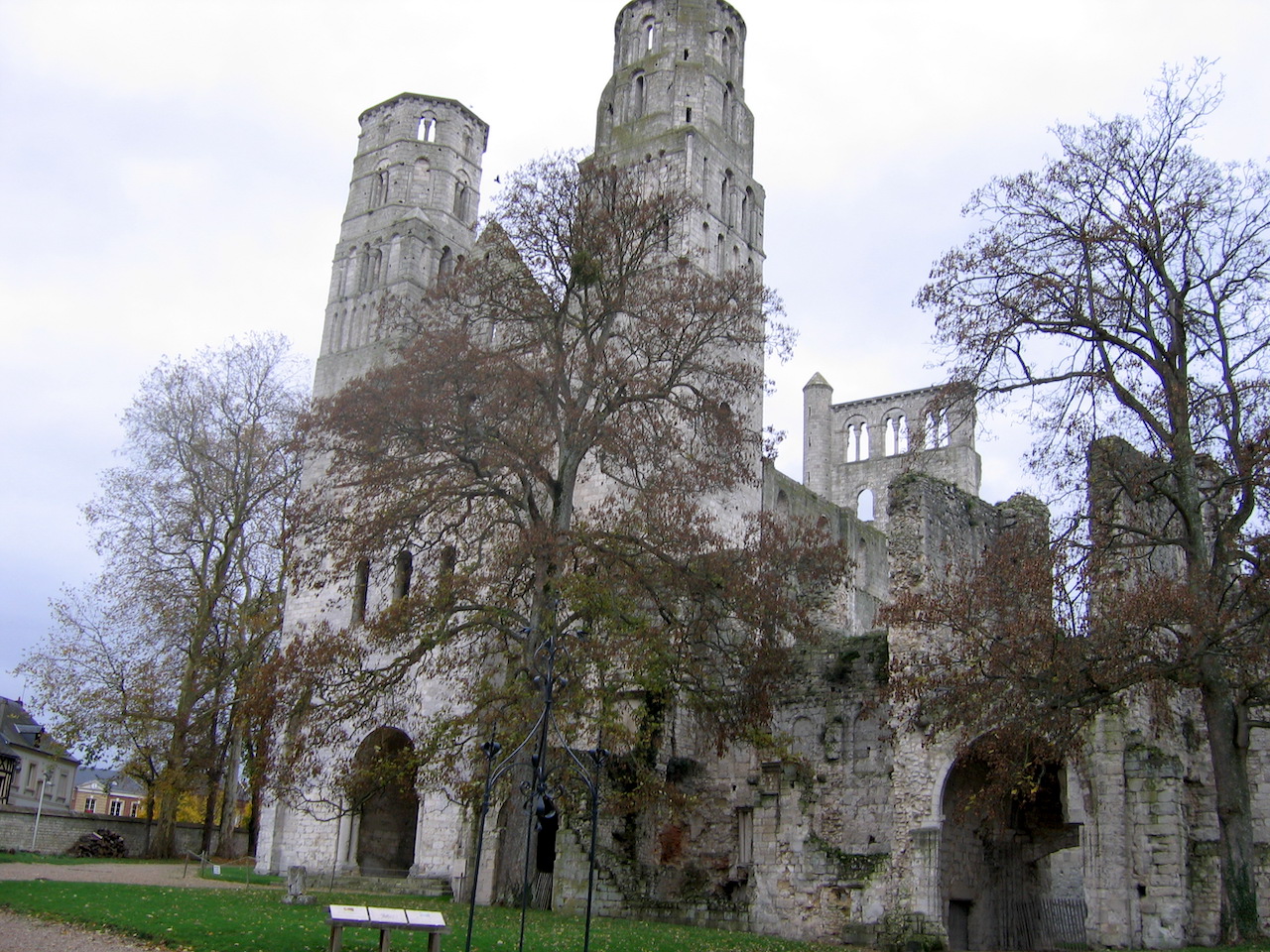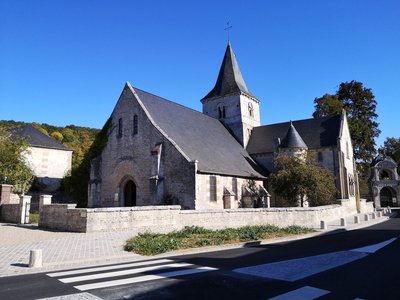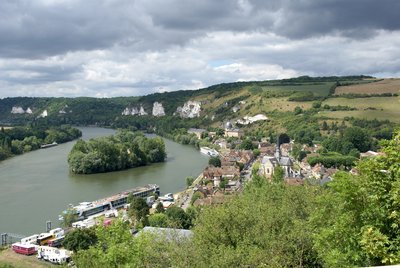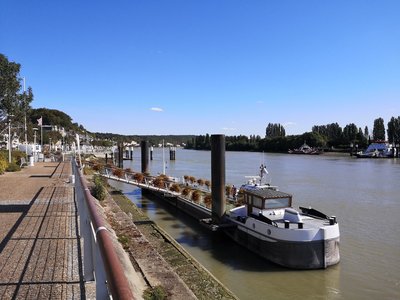Saint-Wandrille-Rançon to Duclair

Normandie
1. Saint-Wandrille-Rançon to Duclair
Medium
6h30
24,8km
+597m
-603m
Step
Embed this item to access it offline
Most of the hiking takes place in the forest. We walk along the Seine on a balcony for about ten kilometers, after passing over a very inhabited area (Le Trait), the path goes down and along the banks of the Seine and then up in the forest of Jumièges to Duclair.
6 points of interest

Église Saint-Michel à Saint-Wandrille - Amis saint Colomban TouristSaint-Michel Church in Saint-Wandrille-Rançon
The parish church, dedicated to Saint Michael, is said to have been built around 735 with materials from Roman monuments in Lillebonne.
In the 9th century, this building was destroyed by Vikings during their raids in the Norman countryside. The building was rebuilt in wood and then in stone in the 11th century. The bell tower is square with its faces provided with a semi-circular semicircular bay with a central column and a cubic capital spread out at the corners. The nave was rebuilt in the 16th century.
Une île sur la Seine aux Andelys - http://www.eau-seine-normandie.fr/ St ColumbanMonastery of Belcinac on an island in the Seine.
Thierry III (654-691) king of Neustrie, son of Clovis II, gave the island of Belcinac to Saint Condède, monk of the abbey of Fontenelle. The latter built a monastery there between 650 and 670. In 675, he donated the island and the monastery to the Abbey of Saint-Wandrille de Fontenelle. As with the establishment of the Abbey of Jumièges, which you will discover during your next stopover, the movement of Luxembourg monasticism will be the spiritual link between all the monastic foundations in the Seine valley. According to some historians this succession of foundations in the Seine can be interpreted as a rampart to the advance of Breton monasticism.
Vue de la nef de l’église Saint-Pierre depuis le chœur disparu - Amis saint Colomban St ColumbanSaint-Pierre de Jumièges Abbey
Notre-Dame de Jumièges Abbey was founded by Saint Philibert, son of a Frankish count.
It was part of the monastic foundations on the banks of the Seine during the 7th and 8th centuries. The majority of these foundations were part of the Luxovien movement during the first century of their creation. Philibert donated his lands to the Rebais monastery, north of Brie, founded by Saint Agil with the help of Saint Eustaise, successor of Saint Colomban at the head of the Luxeuil monastery. Philibert made a name for himself within his community as he was elected abbot of Rebais. He travelled to share the life of the monks of several monastic foundations in Luxeuil before stopping around 654 on an estate of the royal tax office in Jumièges to found his monastery. Like all the monasteries he visited at that time, he placed his brothers under the rule of the "good fathers Benedict and Colomban" until the Council of 818, which imposed on all the monasteries of the Carolingian Empire the rule written by Benedict of Aniane, composed of the precepts of Benedict of Nursia, Saint Colomban of Luxeuil, Saint Pacôme and Saint Basil.
The Abbey of Notre-Dame de Jumièges marks the apogee of Norman monasticism in the Seine valley, preserves the largest and earliest of the great Norman abbeys, is the only one that has remained faithful to the multiplicity of sanctuaries of the very ancient Carolingian monasticism and is one of the keys to Norman Romanesque art where the articulation between Carolingian and Romanesque architecture is most visible.
More information Wikipedia
L’église paroissiale Saint-Valentin de Jumièges - Amis saint Colomban TouristSaint-Valentin Church in Jumièges.
The beautiful parish church of Jumièges, close to the abbey, was built in the 12th century and extensively rebuilt in the 16th century. The interior thus offers a curious mix of Romanesque and Renaissance elements full of charm. Its name recalls the abduction of the relics of Saint Valentine attributed to the monks of Jumièges. It contains elements of decoration and furniture from the abbey, such as the beautiful set of stained glass windows in the choir. The transept has remained unfinished. A temporary bell tower was built in the 16th century and is still visible today. The portal had been redesigned at that time. It is surmounted by a basket-handle arch.
Église Saint-Denis de Duclair - Amis saint Colomban TouristSaint-Denis Church in Duclair
The wave of construction of abbeys also seems to have reached Ducler (medieval name of Duclair) since a division made by Saint Ouen, between Saint Philibert and Saint Wandrille, reveals the existence of a Saint-Denis abbey in Duclair in 671. This would have been destroyed by the Vikings in the 11th century. But as this is the only mention of this abbey here, it could only be an important church.
On a triangular square stands the parish church dedicated to Saint Denis, bishop of Paris and martyr, which dates partly from the 11th and 12th centuries. Facing the calvary stands a pretty little Renaissance portal. The right chevet with three gables dates from the 14th century. The 15th and 16th century stained glass windows have been restored by Max Ingrand.
Le Bord de Seine à Duclair - Amis saint Colomban PanoramicThe banks of the Seine.
At Duclair you can cross the Seine with a ferry. The banks of the river present two different landscapes. On the right bank the town of Duclair with its businesses and its Seine riverside promenade embellished with beautiful Norman houses and the left bank devoted to agriculture and natural sites.
Description
In front of the entrance of the church Saint-Michel de Saint-Wandrille-Rançon straight ahead when crossing the D22 take rue de la Coutume
- First road on the left Chemin du Relais, first road on the left on the edge of the wood, Follow straight ahead, on the right at the junction with the forest road of Caudebecquet.
- First road on the right follow red and white markings, cross the Val des Noyers road across on your right, continue along the red and white markings along the forest edge housing estates, stay on the red and white markings until you reach the Hauteville cemetery.
- Turn right after the cemetery, leaving the red and white markings, rue de Hauteville, first road on the left in the pasture, at the end of the pasture turn right towards La Bucaille, go down rue Joule, turn left on rue Faraday.
- Turn left on rue du Maréchal Foch D 982, right after the electric substation, rue du Bac, left on the road along the Seine, after the third navigation beacon, left on chemin des Iles.
- After the first property of Jumièges on the right, take the stairs on the right to go around the school, pass in front of the Marie, on the left in front of the abbey Notre-Dame rue Guillaume le conqueror D 143, first street on the right rue Mainberte, red and white markings, at the end of the asphalt road on the left dirt road, at the crossroads of the roads on the right chemin de la Forêt continue on asphalt road
- First road on the left, cross the D 982 on the right for a few meters on the left chemin du Taillis, first road on the right follow the red and white signs to Duclair.
- Pass the forest house, chemin de la Forêt, on the right chemin des Noisettes cross chemin de Claquemeure take chemin de Bellevue on the right at the junction with Chemin des Graviers on the right chemin de Bel-Air, go straight down into the woods marked out in red and white.
- Left Côtes des Moulins, right rue de la Ferme, right rue Louis Pasteur continue rue de Verdun you arrive in front of the church Saint-Denis de Duclair.
- Departure : Saint-Michel Church, place de l’Église 76 490 Saint-Wandrille-Rançon
- Arrival : Saint-Denis Church, Place de l’église 76 480 Duclair
- Towns crossed : Normandie
Altimetric profile
Report a problem or an error
If you have found an error on this page or if you have noticed any problems during your hike, please report them to us here:






